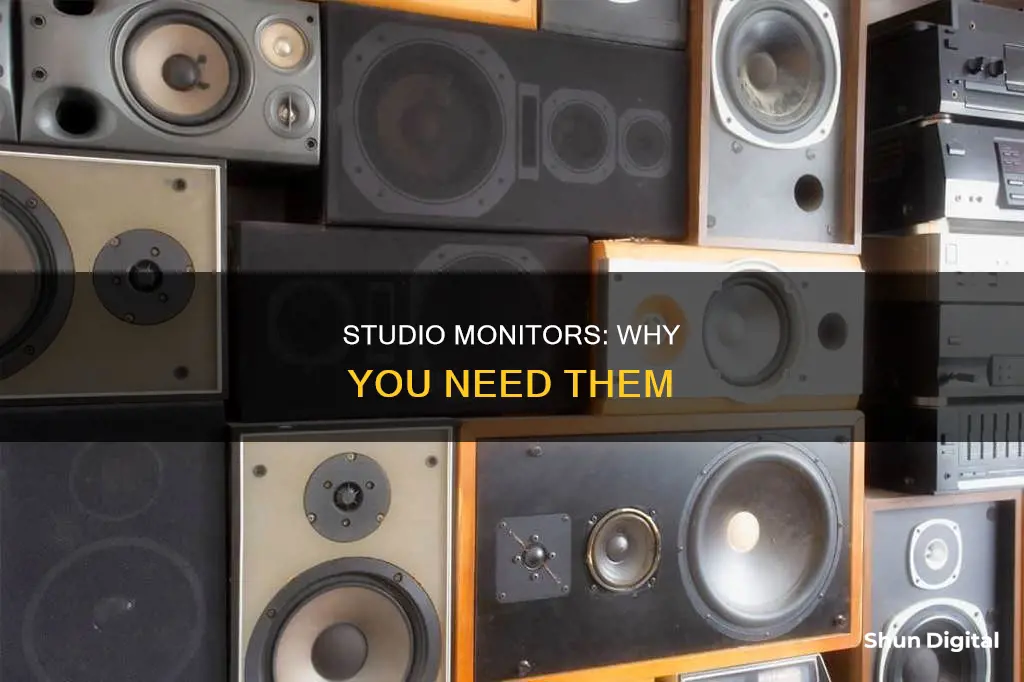
Studio monitors are a must-have for any musician building a home recording studio. Studio monitors are designed to have a flat and clear sound, allowing engineers to hear each part of a recording clearly and identify any flaws in the mix. Unlike home speakers, studio monitors have multiple power amplifiers, powering the bass, midrange, and treble separately. This makes them ideal for creating music, while home speakers are better for listening to the final product. Studio monitors come in two varieties: powered (active) and unpowered (passive). Powered monitors are easy to set up, as they have a built-in amplifier, while unpowered monitors require an external amplifier, which can reduce interference and buzz. When choosing studio monitors, consider the size of your studio, the type of music you create, and whether you need a stereo setup.
What You'll Learn

Studio monitors are designed for clarity
Studio monitors are engineered to deliver a flat and clear sound, allowing engineers to identify and address any flaws in the mix. Each part of the recording, from the bass to the midrange and treble, can be heard distinctly. This level of clarity is achieved through multiple power amplifiers, which power different frequency ranges separately.
The design of studio monitors prioritises accuracy and precision in sound reproduction, making them indispensable tools for music production and engineering. They are a far cry from home speakers, which are designed to provide a brighter and more varied sound for casual listening. Studio monitors are purpose-built to ensure that every nuance of a recording is captured and can be critically evaluated during the mixing and mastering process.
The clarity of studio monitors extends beyond music production. They can also be used anywhere high-quality playback is required, such as recreational listening at home or in professional sound booths. Their versatility means they can even stand in for speaker stacks in smaller venues, showcasing their adaptability and the importance of clear, accurate sound reproduction.
In summary, studio monitors are designed with a focus on clarity, ensuring that every detail of a recording can be heard distinctly. This level of precision is crucial for music professionals, enabling them to create and deliver the best possible sound experience to their audience.
Choosing a Monitor for Better Viewing with Poor Eyesight
You may want to see also

They have multiple power amplifiers
Studio monitors are a must-have for anyone building a home recording studio. They differ from regular speakers in that they have a flatter, clearer sound. Studio monitors also have multiple power amplifiers, dedicated to powering the bass, midrange and treble separately. This means that audio engineers can hear each part of the recording clearly and easily pinpoint any flaws in the mix.
Studio monitors with multiple power amplifiers are ideal for creating music. They offer greater control over the frequency response and more precise sound reproduction. This is achieved through a bi-amp configuration, where each driver has its own dedicated amplifier. In a 2-way studio monitor design, this means that the woofer and tweeter will have separate amplifier channels.
The benefit of having dedicated amplifiers for each driver in a studio monitor is that it allows for a more accurate reproduction of sound. This is especially important in professional studios, where accuracy and detail are of utmost importance. With a bi-amp configuration, engineers can trust that what they are hearing is a true representation of the sound, making it easier to make informed decisions about the audio.
The tri-amp configuration takes this a step further, with each driver in a 3-way speaker system (woofer, midrange, tweeter) having its own dedicated amplifier. This setup is typically used in high-end professional studios, where the highest level of accuracy is required.
When choosing a studio monitor with multiple power amplifiers, it is important to consider the size of the amplifier and the wattage. For a home studio, a 50-75 watt amplifier per channel should be sufficient. However, for a larger commercial studio, you may require an amplifier with more power, such as 100 watts or more per channel.
Replacing LCD Monitor Backlights: A Step-by-Step Guide
You may want to see also

They are essential for a home studio
Studio monitors are essential for a home studio. They are designed to provide a flat and clear sound, allowing audio engineers to hear each part of a recording distinctly and identify any flaws in the mix. This level of clarity is crucial for creating music and ensuring the final product will sound excellent even on high-fi audio systems. Studio monitors enable you to hear every note and vocal with precision, ensuring that your recording is just right.
Studio monitors differ from regular home speakers in their design and purpose. While home speakers offer a brighter and more varied sound, studio monitors focus on delivering an accurate and detailed sound reproduction. This makes them ideal for the music production process, where identifying and fixing issues in the recording is critical. Studio monitors also have multiple power amplifiers, separately powering the bass, midrange, and treble, resulting in a clearer and more controlled sound.
When choosing studio monitors for your home studio, consider the size of your space. If you have a small studio, a compact pair of monitors will likely suffice. However, if you work with a larger soundstage or intend to use the monitors as home stereo speakers, opt for larger ones. Additionally, consider the type of music you create. If your music has a significant low-end frequency presence, select monitors with bigger woofers to deliver more powerful bass.
Another factor to keep in mind is whether you want powered (active) or unpowered (passive) monitors. Powered monitors are more convenient as they have a built-in amplifier and only require a connection to a power outlet and an audio source. This makes them a popular choice for hobby studios and audiophiles. On the other hand, unpowered monitors require an external amplifier, which gives you the flexibility to use the same amp head in the studio and onstage. Unpowered monitors also minimise interference and buzz due to the absence of electrical power components in the cabinet.
Studio monitors are a critical component of any home studio setup, and with the right pair, you'll be able to create and mix music with precision and confidence.
Is My Messenger Being Monitored? Signs to Watch For
You may want to see also

They are different from home speakers
Studio monitors are designed to have a flatter, clearer sound than home speakers. They are also designed for critical listening, allowing you to pick out sonic imperfections so you can fix them. Studio monitors are used for the production aspects of audio products, whereas regular speakers are used for the consumption of audio products.
Studio monitors have multiple power amplifiers, powering the bass, midrange and treble separately. This means that the woofer (bass), midrange and tweeter (treble) cones are each powered individually, making for a more precise sound. Studio monitors also have crossovers, which split frequencies to ensure they go to the right driver (speaker), adding clarity and precision.
Home speakers, on the other hand, have a brighter, more varied sound. They are designed to sound good in any room and from any direction. They have a predetermined frequency setting built into them to distort or amplify certain sounds, changing the way a sound is heard through the speaker. This makes them great for listening to music, but not ideal for producing or recording music.
Studio monitors are also designed for short distances, making them perfect for bedrooms, studios and smaller areas. Powered speakers, on the other hand, are designed to project sound throughout a room and are better suited for living rooms, dens or outdoor areas.
Identifying Monitor Types: LCD vs LED
You may want to see also

They come in two varieties: powered and unpowered
Studio monitors are designed to have a flatter, clearer sound than home speakers. They also have multiple power amplifiers, powering the bass, midrange, and treble separately. Studio monitors are an essential element of any home studio.
Studio monitors come in two varieties: powered and unpowered. Powered speakers feature a built-in power amplifier, while unpowered speakers don't. The power amplifier requires electricity to function, so powered speakers need to be connected directly to an electrical outlet. Unpowered speakers, on the other hand, get their power from an external, independent power amplifier.
Powered speakers are more streamlined and require fewer cables. They are also easier to set up since all the components are included inside the cabinet. However, they are heavier and may be more difficult to mount on walls or ceilings. Additionally, you will need as many outlets as you have speakers.
Unpowered speakers, also known as passive speakers, are lighter and easier to mount. They only require a standard speaker cable. They offer more flexibility as they allow you to create your ideal signal chain by choosing your amplifier, crossover system, and other processing equipment. However, they may require more research, planning, and installation time.
The decision between powered and unpowered studio monitors depends on your specific needs and preferences. If you value convenience and ease of use, powered speakers might be the better choice. If you want the ability to choose every component in your chain, unpowered speakers might be a better option.
Monitoring Internet Usage: Security, Productivity, and Privacy
You may want to see also
Frequently asked questions
Studio monitors are designed to have a flatter, clearer sound than home speakers. They also have multiple power amplifiers, powering the bass, midrange and treble separately. Studio monitors are essential for creating music, as they allow engineers to hear each part of the recording clearly and easily identify any flaws in the mix.
Studio monitors come in two varieties: powered (or active) and unpowered (passive). Powered monitors have a built-in amplifier and are easy to set up, making them ideal for hobby studios or audiophiles. Unpowered monitors require an external amplifier and are preferred by professionals who want to use the same amp head in the studio and onstage.
When choosing studio monitors, consider the size of your studio, the type of music you create, and whether you need monitors for a stereo setup. If you have a small studio, compact monitors should suffice, while larger studios or home stereo setups may require bigger monitors. If your music has a lot of low-end frequencies, opt for monitors with larger woofers for more powerful bass.







